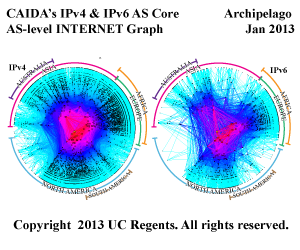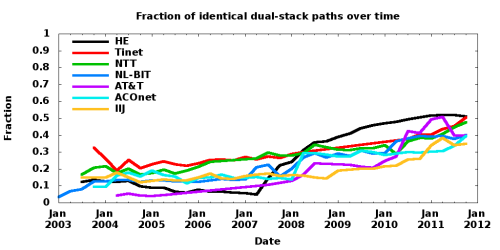CAIDA Delivers More Data To the Public
Wednesday, February 12th, 2014 by Paul HickAs part of our mission to foster a collaborative research environment in which data can be acquired and shared, CAIDA has developed a framework that promotes wide dissemination of our datasets to researchers. We classify a dataset as either public or restricted based on a consideration of privacy issues involved in sharing it, as described in our data sharing framework document Promotion of Data Sharing (http://www.caida.org/data/sharing/).
Public datasets are available for downloaded from our public dataserver (http://data.caida.org) subject to conditions specified in our Acceptable Use Agreement (AUA) for public data (http://www.caida.org/home/legal/aua/public_aua.xml). CAIDA provides access to restricted datasets conditionally to qualifying researchers of academic and CAIDA-member institutions agreeing to a more restrictive AUA (http://www.caida.org/home/legal/aua/).
In January 2014 we reviewed our collection of datasets in order to re-evaluate their classification. As a result, as of February 1, we have converted several popular restricted CAIDA datasets into public datasets, including most of one of our largest and most popular data collections: topology data from the (now retired) skitter measurement infrastructure (operational between 1998 and 2008), and its successor, the Archipelago (or Ark) infrastructure (operational since September 2007). We have now made all IPv4 measurements older than two years (which includes all skitter data) publicly available. In addition to the raw data, this topology data includes derived datasets such as the Internet Topology Data Kits (ITDKs). Further, to encourage research on IPv6 deployment, we made our IPv6 Ark topology and performance measurements, from,December 2008 up to the present, publicly available as a whole. We have added these new public data to the existing category of public data sets, which includes AS links data inferred from traceroute measurements taken by skitter and Ark platforms.
Several other datasets remain under consideration for public release, so stay tuned. For an overview of all datasets currently provided by CAIDA (both public and restricted) see our data overview page (http://www.caida.org/data/overview/).
Support for this data collection and sharing provided by DHS Science and Technology Directorate’s PREDICT project via Cooperative Agreement FA8750-12-2-0326 and NSF’s Computing Research Infrastructure Program via CNS-0958547.

